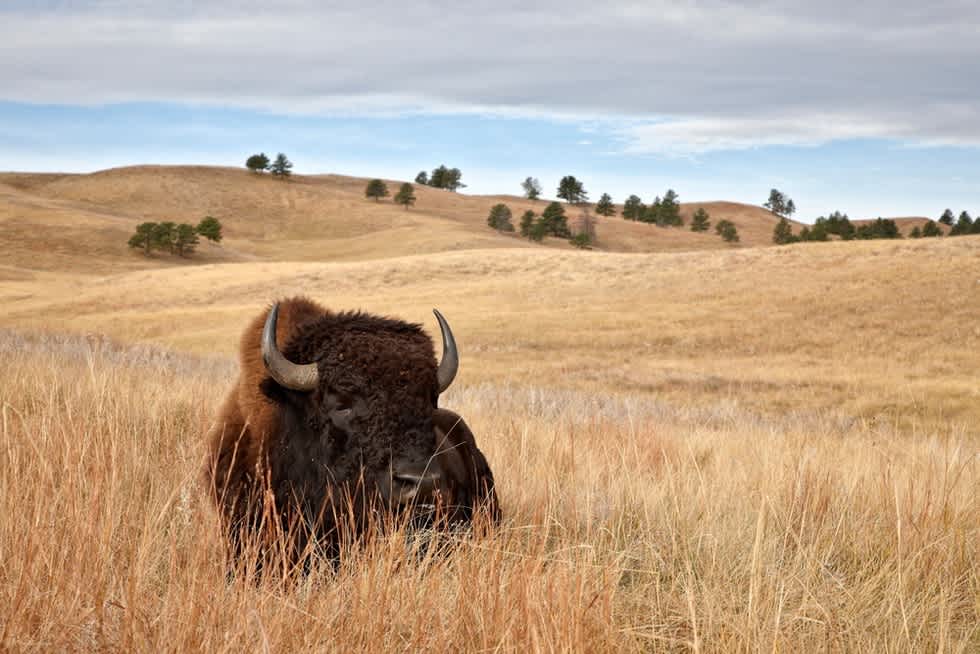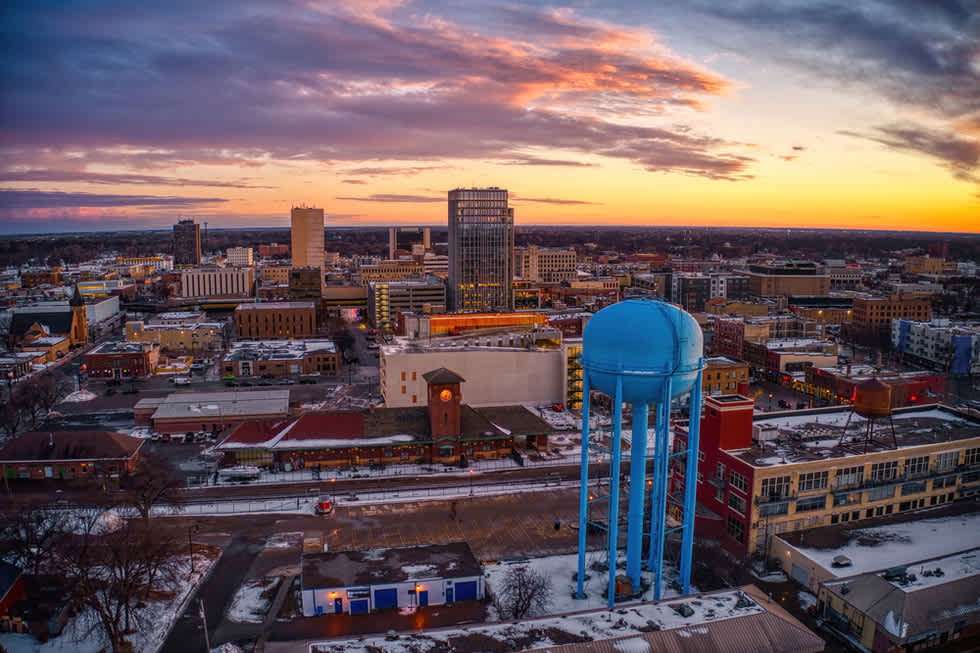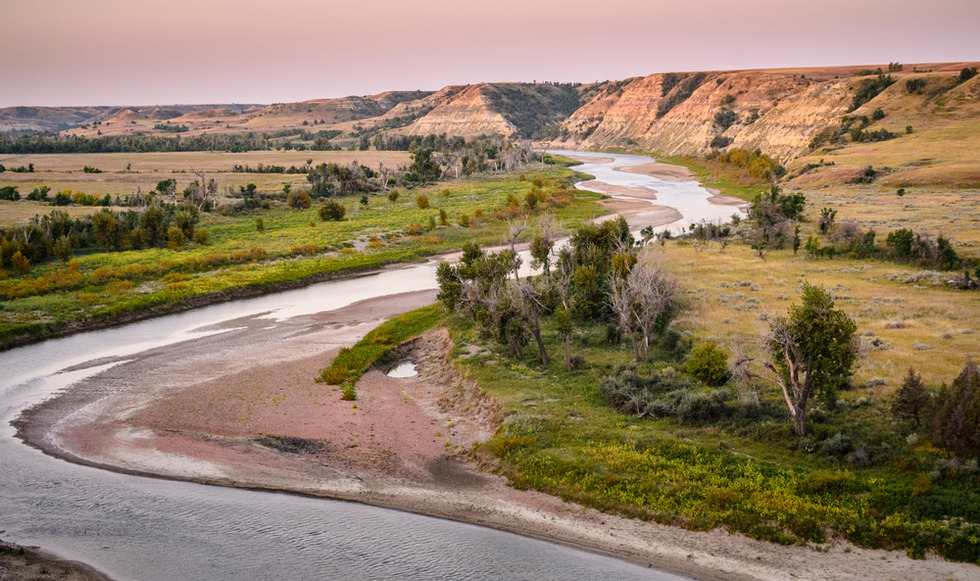Dakota Ridge
- 34 units available
- 2 bed • 3 bed
- Amenities
In unit laundry, Patio / balcony, Granite counters, Hardwood floors, Dishwasher, Pet friendly + more

North Dakota offers a straightforward, no-frills lifestyle with a strong sense of community and a surprisingly affordable cost of living. While often overlooked in national conversations, the Peace Garden State has plenty to offer—wide open skies, low crime, and thriving cities like Fargo and Bismarck. Whether you're raising a family or settling into your career, North Dakota’s balanced pace and financial accessibility make it an easy place to call home.
Compared to neighboring states like Minnesota, Montana, and South Dakota, North Dakota remains one of the most affordable regions in the Upper Midwest. While housing costs have risen slightly in urban centers, most communities remain within reach for individuals, couples, and families alike. From rolling farmland to growing downtowns, North Dakota offers room to breathe—and budget accordingly.
North Dakota is approximately 11.7% below the national average, making it an affordable choice without sacrificing quality of life. The state’s relatively low housing prices are a major factor, with a median home value of around $235,100, well under the national average. Here's how the overall numbers break down:
| Cost of Living | North Dakota | U.S. |
|---|---|---|
| Overall | 88.6 | 100 |
| Grocery | 95.1 | 100 |
| Health | 103.4 | 100 |
| Housing | 82.3 | 100 |
| Median Home Value | $240,700 | $338,100 |
| Utilities | 89.4 | 100 |
| Transportation | 74.4 | 100 |
| Miscellaneous | 92.5 | 100 |
Williston, North Dakota’s largest city, tops the list when it comes to cost of living, thanks to a combination of population growth, demand for housing, and urban amenities. While still affordable by national standards, Williston's cost of living is about 5.3% higher than the state average but still 6.7% lower than the national average, with savings in areas across housing and groceries.
| Cost of Living | Williston | North Dakota | U.S. |
|---|---|---|---|
| Overall | 93.3 | 88.6 | 100 |
| Grocery | 100.8 | 95.1 | 100 |
| Health | 108.2 | 103.4 | 100 |
| Housing | 94.3 | 82.3 | 100 |
| Median Home Value | $296,000 | $240,700 | $338,100 |
| Utilities | 89.9 | 89.4 | 100 |
| Transportation | 69.6 | 74.4 | 100 |
| Miscellaneous | 108.5 | 92.5 | 100 |
On the other end of the spectrum, Jamestown ranks as one of the most budget-friendly places in North Dakota. The city’s overall cost of living is roughly 19.9% below the national average and 9.9% lower than the national average. With lower-than-average housing prices and utility costs, it's a great choice for anyone prioritizing value.
| Cost of Living | Jamestown | North Dakota | U.S. |
|---|---|---|---|
| Overall | 80.1 | 88.6 | 100 |
| Grocery | 97.1 | 95.1 | 100 |
| Health | 110.9 | 103.4 | 100 |
| Housing | 59.4 | 82.3 | 100 |
| Median Home Value | $184,400 | $240,700 | $338,100 |
| Utilities | 88.6 | 89.4 | 100 |
| Transportation | 63.6 | 74.4 | 100 |
| Miscellaneous | 95.1 | 92.5 | 100 |

As of spring 2025, the average rent across North Dakota is $1,108 per month, with savings below the national average of $1,373. Renters can expect consistency across the state, with rates holding steady over the past year. With plenty of space and growing city centers, North Dakota provides value for renters without sacrificing comfort or amenities. Here's a look at what the overall median rent in some of the larger cities in North Dakota cost
North Dakota frequently ranks among the top 15 most affordable states for renters, with small cities and college towns offering lower prices and flexible options. Whether you're looking for a spacious apartment in Grand Forks or a downtown loft in Fargo, there's something to match your lifestyle.
The overall median cost of a one-bedroom apartment across North Dakota is $1,108, but it depends on the city you live in. You can also save more money by looking in smaller cities, like Jamestown, or rural areas. If you want to live in large metro areas in North Dakota, here are the median prices you'll pay for a one-bedroom apartment.
| City | Rent |
|---|---|
| Fargo | $835 |
| Grand Forks | $885 |
Two-bedroom apartments average $1,260 in North Dakota, with Grand Forks and Fargo coming in higher and rural areas offering considerable savings. For families or roommates, North Dakota’s rental market makes it easier to live in a larger space without overextending your budget.
| City | Rent |
|---|---|
| Fargo | $977 |
| Grand Forks | $1,110 |
If you're thinking about buying a home soon, you're in luck: The median home value in North Dakota is $240,700, making homeownership more accessible here than in most of the country. From new builds in suburban Bismarck to century-old farmhouses in smaller towns, there’s a wide range of properties and prices across the state. Even in higher-cost cities, buyers can usually find quality homes for far less than in comparable metros nationwide.
Even with the inexpensive rents, it's important to figure out the right salary to maintain a comfortable cost of living in North Dakota. We recommend following the 30% housing rule, which stipulates spending no more than 30% of your income on rent. If you rent a one-bedroom apartment at the statewide average of $929, you’ll need to earn around $37,160 per year, $3,096.67 per month, or around $17.87 per hour.
The 30% rule is a good place to start, but you should also double-check the living wage in North Dakota. According to the MIT Living Wage data, a single adult in North Dakota needs to make about $19.78 an hour, or $41,142.40 per year, to cover basic living expenses. That figure covers basics from housing to food and transportation. However, it does not take into account debt repayments, travel, savings, or splurges.
We also wanted to explore what the U.S. Census Bureau data has to say about the median household income in North Dakota. Their research shows the median household earns $75,949 a year, $6,329.08 a month, or about $36.51 an hour, which puts you well above the living wage. With high-paying jobs in manufacturing, agriculture, healthcare, mining, construction, and energy, newcomers can find a career that offers an affordable lifestyle with plenty of breathing room in their budget.

Public transportation in North Dakota is scarce outside of areas like Fargo and Grand Forks. If you live in these cities, you can rely on rideshares and public transit to save money. Fargo's Metropolitan Area Transit System (MATBUS) starts at $1.50 or $42 for a 31-day period. In Grand Forks, Cities Area Transit (CAT) fares start at $2 and a monthly pass costs just $40.
Most North Dakota residents rely on personal vehicles, but commute times are short, and fuel costs are moderate. According to MIT estimates, a single adult will spend about $10,822 per year on transportation, while a two-parent, two-child household will spend around $18,153 annually.
Food will always take up a big portion of your budget, but fortunately, grocery costs in North Dakota tend to hover just below national averages. Annual food expenses for a single adult are around $4,233, while a family of four will spend about $15,777. A single adult in Fargo will spend $4,362 per year on food and $12,784 for a family of four. Smaller towns offer more budget-friendly food costs.
Wherever you live, leave some room in your budget to eat out and sample the local fare. North Dakota's local food scene is full of agricultural hearty delights, including durum wheat, honey, and Scandinavian dishes that include tater tot hotdish, cheese buttons, and knoephla soup.
Here are some examples of food costs from Numbeo:
With so many farms and agricultural outlets in North Dakota, you can get fresh food and save some money browsing local co-ops and farmers' markets.
Child care remains a significant cost for North Dakota families that takes up a significant portion of a budget. A single child averages $11,201 per year, while care for two children comes in around $21,595 annually, according to MIT’s data. Cities with larger populations may see higher prices, but statewide, child care is more affordable than in many other regions of the country. If you're on a tight budget, working a flexible remote schedule or teaming up with another family and sharing a nanny can help reduce costs.
Staying healthy is an important part of keeping your cost of living in North Dakota low. Take good care of yourself and keep up with preventative measures and checkups. North Dakota’s healthcare costs are somewhat below the national average, with a single adult spending around $2,796 per year and a family of four averaging about $9,800.
Access to hospitals, clinics, and telehealth services is widely available, especially in major cities. North Dakota's Health and Human Services department offers resources for help with health costs, including pregnancy and substance use disorders.
North Dakota experiences some extreme temperatures, with January temperatures dipping to an average of 2°F in the north to 17°F in the southwest. In July, you'll see temperatures only reaching 67°F in the north and 73°F in the south. However, that doesn't mean you won't see temperatures that rise above 90°F or plunge below 0°F.
Fortunately, utilities aren't outrageous in North Dakota, but you still need to factor in some extra room in your budget during the cold winter months. Here's what you might expect to pay monthly for a 915 sq ft apartment:
$159.44 (+ $57.81 for Internet (60 Mbps or More, Unlimited Data, Cable/ADSL)
$278.73 (+ $76.17 for Internet (60 Mbps or More, Unlimited Data, Cable/ADSL)
Compare that to the U.S. average of $208.56 for basic utilities, and you’ll see North Dakota remains budget-friendly.
Kansas makes it easy to enjoy an active lifestyle with plenty of outlets for affordable fitness memberships in North Dakota that average between $47 to $60/month, while movie tickets range from $13.75 to $15 (not including popcorn, drinks, and other snacks.
Outdoor enthusiasts will love the state’s free and low-cost recreation options. You’ll find stunning hiking trails in Theodore Roosevelt National Park and year-round fun at places like Fort Abraham Lincoln State Park. A state park day pass runs about $7 per vehicle, making it easy to stay active and entertained without breaking the bank.

North Dakota’s state income tax ranges from 1.1% to 2.9%, among the lowest in the nation. The sales tax rate is 5%, with local additions pushing it up to around 6.5–7.5% in some areas. Property taxes are moderate, averaging about 1.02%, and the state imposes no estate or inheritance tax, making it financially appealing for both retirees and growing families.
North Dakota’s unemployment rate stands at 2.5%, significantly below the national average. Fargo, Grand Forks, and Bismarck are driving much of the growth, with strong demand in energy, agriculture, healthcare, and logistics. The state projects steady job creation through 2026, particularly in skilled trades and healthcare.
If you're seeking low costs, high quality of life, and wide-open opportunities, North Dakota checks all the boxes. Whether you're drawn to a booming city like Fargo or prefer the charm of a smaller town like Devils Lake, there’s a space and a pace to fit your lifestyle. Ready to make the move? Start your North Dakota apartment search today with Apartment List. With us, you’ll spend five minutes and save 50 hours searching.
Kansas remains a top choice for budget-conscious homebuyers and renters in 2025. With the average home priced around $240,700, housing costs are comfortably beneath the national median. Renters also enjoy some of the country’s best rates, paying an average of just $1,108 per month. This keeps Kansas ranked among the 15 most affordable states for renters in the U.S.
The cheapest rents in Kansas are one bedroom apartments. In Kansas City, the median one-bedroom rent is $861. In Topeka, the median one-bedroom rent is $829. In Wichita, the median one-bedroom rent is $803. You can look to more rural areas and suburbs to save even more money on rent.
North Dakota offers a refreshing blend of affordability, community spirit, and natural beauty that makes it an underrated gem for those seeking a high quality of life. The state consistently boasts a cost of living that’s lower than the national average, allowing your paycheck to stretch further without sacrificing comfort or convenience. You can still choose a reasonably sized metro area like Fargo or opt for the peacefulness of wide-open prairies, close-knit feel of smaller towns. Despite the frigid winters, it's ideal for an outdoor lifestyle that comes with living near trails, rivers, and open skies that's free to enjoy.
As of July 1, 2024, North Dakota's estimated population was 796,568. That figure grew from 779,079 in 2020, showing a modest 17,489 increase in population.

In unit laundry, Patio / balcony, Granite counters, Hardwood floors, Dishwasher, Pet friendly + more
In unit laundry, Patio / balcony, Dishwasher, Pet friendly, New construction, 24hr maintenance + more